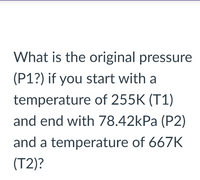
Chemistry
10th Edition
ISBN: 9781305957404
Author: Steven S. Zumdahl, Susan A. Zumdahl, Donald J. DeCoste
Publisher: Cengage Learning
expand_more
expand_more
format_list_bulleted
Concept explainers
Question

Transcribed Image Text:What is the original pressure
(P1?) if you start with a
temperature of 255K (T1)
and end with 78.42kPa (P2)
and a temperature of 667K
(T2)?
Expert Solution
This question has been solved!
Explore an expertly crafted, step-by-step solution for a thorough understanding of key concepts.
Step by stepSolved in 2 steps with 1 images

Knowledge Booster
Learn more about
Need a deep-dive on the concept behind this application? Look no further. Learn more about this topic, chemistry and related others by exploring similar questions and additional content below.Similar questions
- 3:27 AM Tue Jan 31 < Question 7 of 17 What is the temperature (in K) of 3.04 mol N₂ in a 50.0 L container at 122 kPa? Oarrow_forwardwhat would be the pressure of the gas that starts at 115 kpa and 25 degrees celcuis that is heated to 259 degrees celcuis?arrow_forwardA tire at a pressure of 760 kPa is heated from 0°C to 100.0°C. What is the new pressure?arrow_forward
- The combustion of propane is described by the chemical equation C3H8 (g) +502(g) → 3CO2(g) + 4H₂O(g) . If we have a partial pressure of 0.375 bar of propane as the reactant, what partial pressure of oxygen will we need to have a perfect amount to consume all of the propane with no unreacted propane or oxygen left over at the end of the reaction? 1.13 kPa 0.0750 bar 0.375 bar 1.88 bararrow_forwardI need help with part A and Barrow_forwardAnswer part a and barrow_forward
- I only need help with part barrow_forwardUse the van der Waals equation of state to calculate the pressure of 3.30 mol of HI at 483 K in a 4.60 L vessel. Van der Waals constants can be found in the van der Waals constants table. P = atm Use the ideal gas equation to calculate the pressure under the same conditions. P = atm Under these conditions, would you expect HI or CCl, to deviate more from ideal behavior? Why? CCl because it occupies a larger volume and it has smaller dispersion forces between molecules. HI because it occupies a smaller volume and it has smaller dispersion forces between molecules. HI because it occupies a larger volume and it has smaller dispersion forces between molecules. CCI, because it occupies a larger volume and it has greater dispersion forces between molecules. HI because it occupies a smaller volume and it has greater dispersion forces between molecules. CCI, because it occupies a smaller volume and it has greater dispersion forces between molecules.arrow_forward1. Many laboratory gases are sold in steel cylinders with a volume of 43.8 L. If there are x kilograms of argon inside a cylinder whose pressure is 4,733 kPa at 11°C, what the value of x? (1 atm = 101325 Pa)arrow_forward
- A 2.61 gram sample of a solid mixture contains NaClO3 as well as unreactive material. When heated, only the NaClO3 in the mixture decomposes to produce 992 milliliters of O2 gas at 225◦C and 772 mmHg according to the unbalanced equation NaClO3(s) −→ NaCl(s) + O2(g). What is the percent by mass of NaClO3 in the mixture?arrow_forwardIf V= 9.14L at 24 C, Find V= ? at 49 C if pressure and moles are constantarrow_forwardA 1.50-liter sample has a pressure of 138 kPa at 12°C. What temperature would this sample be if it expanded to 2.43 liters under a pressure of 236 kPa?arrow_forward
arrow_back_ios
SEE MORE QUESTIONS
arrow_forward_ios
Recommended textbooks for you
 ChemistryChemistryISBN:9781305957404Author:Steven S. Zumdahl, Susan A. Zumdahl, Donald J. DeCostePublisher:Cengage Learning
ChemistryChemistryISBN:9781305957404Author:Steven S. Zumdahl, Susan A. Zumdahl, Donald J. DeCostePublisher:Cengage Learning ChemistryChemistryISBN:9781259911156Author:Raymond Chang Dr., Jason Overby ProfessorPublisher:McGraw-Hill Education
ChemistryChemistryISBN:9781259911156Author:Raymond Chang Dr., Jason Overby ProfessorPublisher:McGraw-Hill Education Principles of Instrumental AnalysisChemistryISBN:9781305577213Author:Douglas A. Skoog, F. James Holler, Stanley R. CrouchPublisher:Cengage Learning
Principles of Instrumental AnalysisChemistryISBN:9781305577213Author:Douglas A. Skoog, F. James Holler, Stanley R. CrouchPublisher:Cengage Learning Organic ChemistryChemistryISBN:9780078021558Author:Janice Gorzynski Smith Dr.Publisher:McGraw-Hill Education
Organic ChemistryChemistryISBN:9780078021558Author:Janice Gorzynski Smith Dr.Publisher:McGraw-Hill Education Chemistry: Principles and ReactionsChemistryISBN:9781305079373Author:William L. Masterton, Cecile N. HurleyPublisher:Cengage Learning
Chemistry: Principles and ReactionsChemistryISBN:9781305079373Author:William L. Masterton, Cecile N. HurleyPublisher:Cengage Learning Elementary Principles of Chemical Processes, Bind...ChemistryISBN:9781118431221Author:Richard M. Felder, Ronald W. Rousseau, Lisa G. BullardPublisher:WILEY
Elementary Principles of Chemical Processes, Bind...ChemistryISBN:9781118431221Author:Richard M. Felder, Ronald W. Rousseau, Lisa G. BullardPublisher:WILEY

Chemistry
Chemistry
ISBN:9781305957404
Author:Steven S. Zumdahl, Susan A. Zumdahl, Donald J. DeCoste
Publisher:Cengage Learning

Chemistry
Chemistry
ISBN:9781259911156
Author:Raymond Chang Dr., Jason Overby Professor
Publisher:McGraw-Hill Education

Principles of Instrumental Analysis
Chemistry
ISBN:9781305577213
Author:Douglas A. Skoog, F. James Holler, Stanley R. Crouch
Publisher:Cengage Learning

Organic Chemistry
Chemistry
ISBN:9780078021558
Author:Janice Gorzynski Smith Dr.
Publisher:McGraw-Hill Education

Chemistry: Principles and Reactions
Chemistry
ISBN:9781305079373
Author:William L. Masterton, Cecile N. Hurley
Publisher:Cengage Learning

Elementary Principles of Chemical Processes, Bind...
Chemistry
ISBN:9781118431221
Author:Richard M. Felder, Ronald W. Rousseau, Lisa G. Bullard
Publisher:WILEY